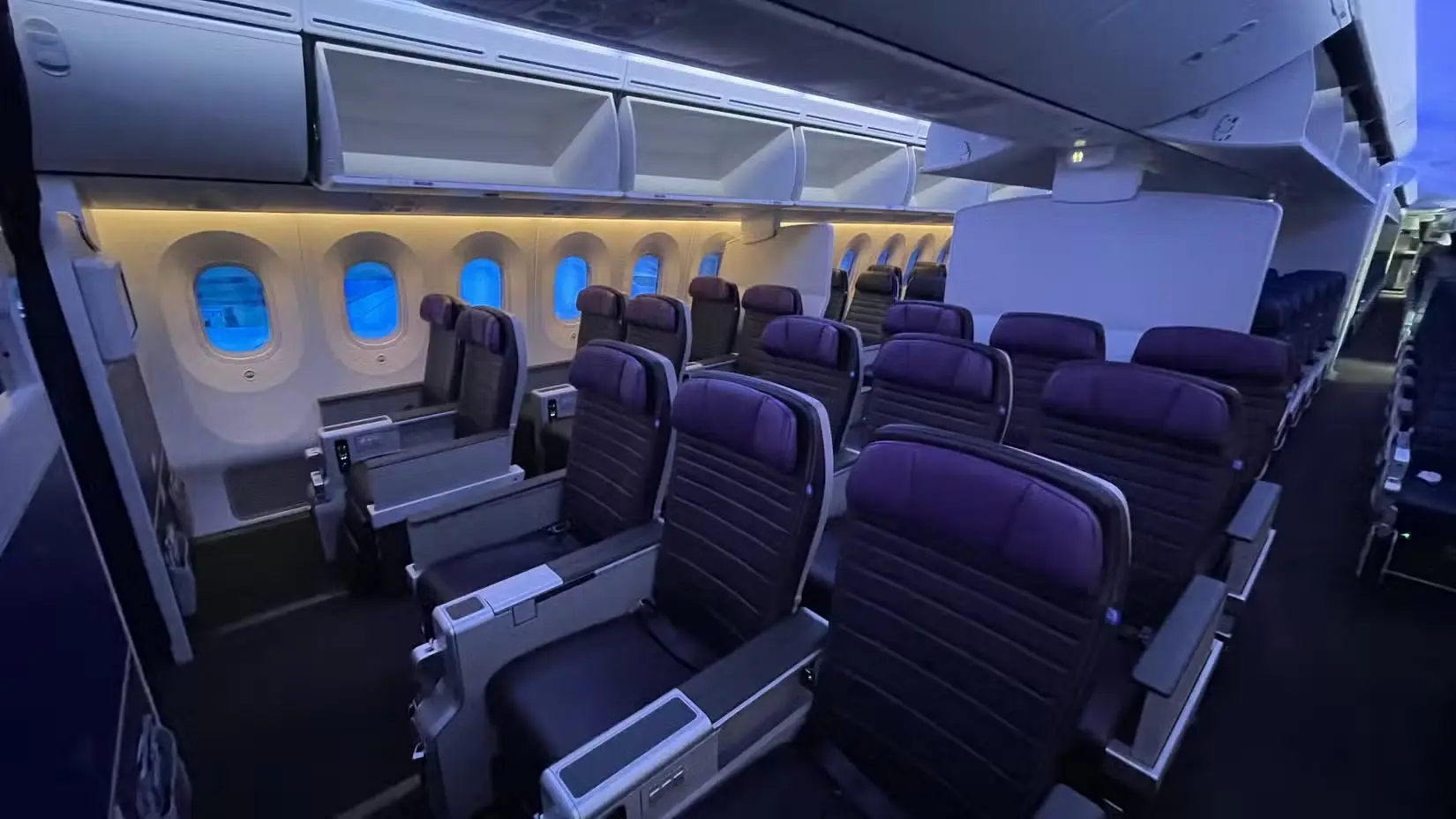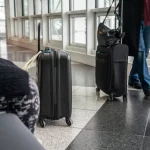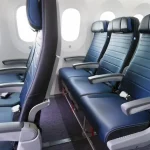Key Takeaways
- Sweet spot pricing: Worth it for $200-400 upgrades, questionable value above $500 per person.
- Aircraft matters enormously: 787 Dreamliner delivers the best experience, avoid older 767 configurations when possible.
- Route strategy: Overnight flights to Europe show biggest value, domestic transcontinental often disappointing
- Hidden problems: Footrests are mostly useless, power outlets require contortionist skills, shares economy bathrooms.
The Truth About Premium Plus After 50,000+ Miles
After flying United Premium Plus on 12 different routes over 18 months – including disasters that cost me $800 for essentially wider economy seats – here’s what actually matters when deciding whether to upgrade. Most travel blogs give you sanitized reviews based on single flights, but Premium Plus quality varies dramatically by aircraft, route, and even which specific seat you book.
I’ve experienced Premium Plus on 767-300ER, 777-300ER, and 787-9 aircraft across routes from 6-hour domestic transcons to 15-hour Pacific flights. The $200 upgrade from SFO to Munich delivered exceptional value. The $450 upgrade from Newark to Athens felt like getting robbed. Understanding why requires digging into operational details most travelers never discover.
The fundamental question isn’t whether Premium Plus beats economy – it obviously does with 38″ pitch versus 31″, wider seats, and better meals. The real question is whether those improvements justify the premium United charges, and that answer depends heavily on factors beyond United’s marketing promises.
Premium Plus exists because United recognized a gap between overcrowded economy and expensive business class. But executing that middle-ground product consistently across different aircraft types and routes has created massive experience variations that most travelers don’t expect.
Premium Plus Pricing Reality: When It Makes Sense
The Sweet Spot Range
$200-400 upgrades represent genuine value for flights over 7 hours, particularly overnight routes where sleep quality matters. I’ve paid $225 for SFO-FRA Premium Plus and considered it excellent value – the wider seat, decent meals, and extra recline made the 11-hour flight significantly more comfortable than cramped economy.
Above $500 per person, the math gets questionable unless you’re dealing with a special situation like honeymoons or important business travel where arriving rested matters enormously. At $800+ upgrades, you’re approaching business class territory on sale fares.
Pricing Chaos and Opportunity
United’s Premium Plus pricing shows no logic – I’ve seen it cost $50 more than economy and $2,400 more than economy on similar routes. Sometimes Premium Plus costs less than regular economy due to inventory management algorithms that make no sense to normal humans.
Real examples from my bookings:
- SFO-MUC: $225 upgrade (excellent value)
- EWR-ATH: $450 upgrade (overpriced for experience delivered)
- ORD-LHR: $180 upgrade (steal, booked immediately)
- IAH-FRA: $720 upgrade (passed, waited for better options)
Strategic booking timing: Premium Plus inventory gets released in waves. Check prices 3-4 weeks out, then again 10-14 days before departure when United sometimes dumps inventory at reduced rates.
The Miles vs Cash Decision
Award pricing runs 300,000-360,000 miles roundtrip for transatlantic Premium Plus, worth roughly $3,300-3,960 based on current mile valuations. Unless you’re sitting on huge mile balances, cash often provides better value for Premium Plus upgrades.
PlusPoints upgrade strategy: Premier members can use PlusPoints for Premium Plus upgrades, typically 20-30 points depending on route. This can be good value if you’re swimming in PlusPoints but need to preserve cash.
Aircraft Type Makes Everything: The Real Hierarchy
Boeing 787 Dreamliner: The Premium Plus Gold Standard
Configuration: 2-3-2 layout with 21 total Premium Plus seats across 3 rows. The cabin pressure equivalent to 6,000 feet altitude versus 8,000 feet on older aircraft reduces fatigue and jet lag noticeably.
Why it works: Modern seat design with actually functional footrests, better entertainment screens, larger windows with electronic dimming, and noticeably quieter cabin environment. The Premium Plus section feels separate from economy rather than just wider economy seats.
Best routes: United deploys 787s on longer routes like SFO-SIN, ORD-DEL, and seasonal European destinations. Worth specifically targeting these aircraft for Premium Plus bookings.
Boeing 777-300ER: The Compromise Choice
Configuration: 2-4-2 layout with more Premium Plus seats but older cabin design. The middle section with 4 seats across creates cramped feeling despite wider individual seats.
Mixed experience: Adequate for overnight flights where you’ll sleep anyway, but the older entertainment system and less refined cabin environment show the aircraft’s age. The 60 total Premium Plus seats create more availability but service quality varies.
Strategic consideration: Acceptable if priced right, but don’t pay premium rates for 777 Premium Plus when 787 routes are available.
Boeing 767-300ER: Avoid When Possible
Configuration: 2-2-2 layout sounds good but cramped cabin proportions and dated amenities disappoint. This is United’s oldest Premium Plus configuration and shows its age.
Footrest disaster: The footrests on 767 Premium Plus are essentially unusable – too low, immovable, and they make underseat storage impossible. I’ve watched passengers struggle with these on multiple flights.
Limited routes: Mostly used on some transatlantic routes and select domestic transcons. Consider regular Economy Plus instead unless Premium Plus pricing is exceptional.
The Premium Plus Experience: What Actually Works vs Marketing
Seating Reality Beyond the Numbers
38″ pitch delivers meaningful improvement over economy’s 31″, but the seat width advantage (19″ vs 17-18″) is less dramatic than expected. Taller passengers notice the legroom immediately, while shorter passengers mainly benefit from the recline angle.
Recline quality varies by aircraft: 787 Premium Plus reclines to genuinely comfortable sleeping angles. 767 recline feels minimal despite the same 6″ specification. Aircraft age and seat mechanism quality matter enormously.
Bulkhead seat strategy: First-row Premium Plus provides maximum legroom but requires storage in overhead bins during takeoff/landing. Entertainment screens fold up from center consoles, which can be awkward for solo travelers.
Want real-time Premium Plus seat maps and aircraft intelligence? Join our United Premium Plus Strategy forum where members share current configurations and seat-specific experiences.
Service Quality: The Good and Disappointing
Meal service improvement is real but modest – food arrives on actual plates with metal silverware versus economy’s plastic everything. Taste quality remains airline food, but presentation and service style feel more refined.
Free alcohol advantage: Premium Plus includes wine, beer, and spirits versus economy’s beer and wine only on international flights. Not a huge perk but nice for longer flights.
Priority boarding reality: Group 2 boarding sounds good but comes after elite members, military, families, and Group 1. Still means 5-6 groups board before you, reducing the practical benefit.
Amenity Kit and Comfort Items
Saks Fifth Avenue blanket and pillow provide genuine comfort improvement over economy versions. The blanket is notably softer and warmer – I’ve seen passengers take them home as souvenirs.
Away amenity kit includes useful items: Sunday Riley skincare products, eye mask, earplugs, dental kit, and compression socks. Higher quality than typical airline amenity kits though not business-class level.
Noise-reducing headphones work adequately for entertainment but don’t approach premium brand quality. Fine for movies, insufficient for serious music listening.
The Problems Nobody Mentions in Reviews
Bathroom Situation
Premium Plus shares economy bathrooms despite the premium pricing. On busy flights, you’re competing with 200+ economy passengers for the same facilities. Business class bathrooms are sometimes accessible but depends on crew enforcement.
Location disadvantage: Premium Plus sits between business and economy, meaning bathroom access requires walking through one section or the other. Not convenient during meal service or when trying to sleep.
Power and Connectivity Issues
Outlet accessibility requires flexibility training – power ports are located in awkward armrest positions that require contorting to reach. I’ve seen passengers unable to plug in devices due to the poor placement.
USB ports work but slowly – adequate for maintaining device charge but insufficient for rapid charging during flights. Bring backup power banks for longer flights.
WiFi pricing unchanged: Premium Plus pays the same WiFi rates as economy despite the premium cabin designation. Free messaging only, full internet requires $20-30 per flight.
Storage and Space Limitations
Underseat storage often compromised by footrest mechanisms, particularly on 767 aircraft where the footrests make personal item storage impossible. Plan for overhead bin space for everything.
Seatback pocket size varies dramatically by aircraft type. Bulkhead seats often have tiny wall pockets that barely accommodate a water bottle and phone.
Route-Specific Value Analysis
Overnight Transatlantic: Maximum Value
Europe routes show Premium Plus at its best – the wider seat and deeper recline make sleeping significantly more comfortable than economy. Arrival fatigue is noticeably reduced on 7+ hour overnight flights.
Best value routes: Newark/Chicago/Washington to London/Amsterdam/Frankfurt where Premium Plus regularly prices $200-350 above economy. The sleep benefit justifies the premium.
Transpacific: Hit or Miss
Depends heavily on aircraft type – 787 Dreamliner routes like SFO-SIN deliver exceptional Premium Plus experiences. Older 777 routes to Tokyo feel more like expensive economy plus.
Time zone considerations: Eastbound Pacific flights (US to Asia) benefit more from Premium Plus comfort due to difficult sleep timing. Westbound flights during daylight hours show less value.
Domestic Transcontinental: Often Disappointing
5-6 hour flights don’t justify Premium Plus premiums unless priced under $200 above economy. The experience improvement is real but not proportional to the upgrade cost.
Airport lounge access missing: Domestic Premium Plus doesn’t include United Club access, removing a major perk that would improve the value proposition.
Track real Premium Plus pricing and share route-specific experiences in our Premium Plus Value Tracking forum where members post daily pricing updates and route recommendations.
Community Consensus: What Frequent Flyers Actually Think
The Positive Experiences
Overnight flight advocates: Reddit and community reports consistently praise Premium Plus for European red-eyes and longer international routes. The sleep quality improvement shows real value for important trips.
Value hunters: Travelers who snag Premium Plus upgrades under $300 report high satisfaction rates. The experience delivers when properly priced.
Aircraft preference patterns: 787 Dreamliner Premium Plus receives consistently positive reviews while 767 experiences get mixed responses. Aircraft type knowledge matters enormously.
The Disappointment Stories
Overpriced expectations: Multiple reports of $600+ Premium Plus upgrades that delivered economy-plus experience with slightly better meals. Pricing above $500 rarely satisfies expectations.
Footrest complaints: Nearly universal complaints about footrest design, particularly on older aircraft. “Useless and annoying” is the common description.
Service inconsistency: Premium Plus service quality varies dramatically by route and crew. Some flights deliver business-class-style service, others feel like economy with wider seats.
Strategic Decision Framework: When to Book Premium Plus
Strong Yes Scenarios
Overnight flights over 8 hours priced under $400 upgrade – the sleep benefit and arrival comfort justify the premium, especially for business travel or special occasions.
787 Dreamliner routes where Premium Plus showcases United’s best product execution. Target these aircraft specifically when available. Sold-out economy situations where Premium Plus provides the only available seats with reasonable comfort levels.
Proceed with Caution
Domestic routes over $200 upgrade unless you specifically need the wider seat for medical or comfort reasons. The value proposition weakens significantly on shorter flights.
767 aircraft Premium Plus unless priced exceptionally well. The older cabin design and problematic footrests reduce satisfaction significantly.
Hard No Situations
Premium Plus priced above $500 per person except for truly special occasions. You’re approaching business class sale territory without business class benefits.
Short flights under 5 hours where the comfort improvement doesn’t justify any significant premium over Economy Plus seating.
The bottom line on Premium Plus: it delivers meaningful improvements when properly priced and deployed on appropriate aircraft. The experience varies enormously by route, aircraft, and pricing, making strategic selection more important than simply assuming all Premium Plus bookings provide good value.
Share your Premium Plus experiences and get real-time pricing alerts in our United Premium Plus Intelligence forum where members track the best deals and route-specific value assessments.
FAQ: United Premium Plus Reality Check
What’s a fair price to pay for Premium Plus upgrades?
$200-400 for international flights over 7 hours represents good value. Above $500, consider waiting for business class sales instead.
Which aircraft should I target for Premium Plus?
Boeing 787 Dreamliner routes provide the best Premium Plus experience. Avoid 767 configurations when possible due to outdated amenities.
Does Premium Plus include lounge access?
No free lounge access, only discounted United Club passes. Major disappointment compared to competitors’ premium economy offerings.
Are the footrests actually useful?
Mostly no – they’re poorly designed on most aircraft and often make underseat storage impossible. Don’t factor footrests into your upgrade decision.
Is Premium Plus worth it for domestic flights?
Generally no unless priced under $200 above economy. The improvements don’t justify significant premiums on shorter domestic routes.
Related guides on United Polaris:





